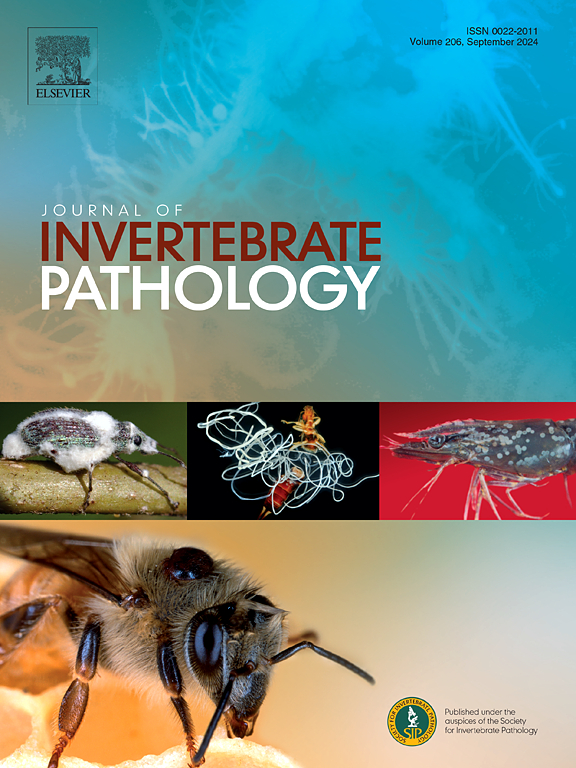Biological and genomic characterization of a cypovirus isolated from golden muga silkworm, Antheraea assamensis Helfer (Lepidoptera: Saturniidae)
IF 2.4
3区 生物学
Q1 ZOOLOGY
引用次数: 0
Abstract
A potential viral pathogen, cypovirus causing cytoplasmic polyhedrosis in the Indian golden muga silkworm, Antheraea assamensis Helfer, was isolated and characterized. Electron microscopy analysis confirmed the presence of typical occlusion bodies with icosahedral virions embedded in polyhedral matrices. The viral genome was dsRNA totaling approximately 24.9 kb in size, divided into 10 discrete segments containing one single open reading frame (ORF) each. Genomic analysis revealed conserved non-coding sequences such as ‘AGUAAU’ and ‘AUAGAGC’ at 5′ and 3′ termini, respectively. Functional annotation identified the presence of structural proteins, such as major and minor capsid proteins, as well as enzymatic proteins, including RNA-dependent RNA polymerase (RdRp). Phylogenetic analysis using deduced amino acid sequences of viral RdRp gene indicated a close evolutionary relationship between the cypovirus isolated from Antheraea assamensis and Antheraea mylitta cypovirus 4 (AmCPV4), thus we named the Indian golden muga silkworm cypovirus as Antheraea assamensis cypovirus 4 (AaCPV4). Nevertheless, AaCPV4 does not have a genomic segment 11 which was earlier reported in AmCPV4. Bioassay studies demonstrated high virulence, with 100 % larval mortality observed within 12 days of infection due to cytoplasmic polyhedrosis. Tissue tropism studies revealed significant viral replication in the midgut, hemolymph, and malpighian tubules, with the midgut exhibiting the highest viral load (9.65 log copy number of RdRp gene/µg of RNA). Cross-transmission experiments demonstrated AaCPV4 host specificity, infecting only in Antheraea species (A. mylitta and A. assamensis), while other lepidopteran insects including silkworms Bombyx mori, and Samia ricini were not susceptible to AaCPV4 infection. According to morphological, genetic, and biological characteristics, we suggest that AaCPV4 is an isolate of the species Cypovirus antheraeae (family Spinareoviridae).

金蚕蚕(Antheraea assamensis Helfer)一种嗜水病毒的生物学和基因组学特性分析(鳞翅目:家蚕科)
分离并鉴定了印度金蚕蚕细胞质多角体病的一种潜在病毒病原体——嗜银病毒。电镜分析证实了典型的封闭体的存在,二十面体病毒粒子嵌入多面体基质。病毒基因组为dsRNA,总大小约为24.9 kb,分为10个独立的片段,每个片段包含一个开放阅读框(ORF)。基因组分析显示,在5 ‘和3 ’端分别存在“AGUAAU”和“AUAGAGC”等保守的非编码序列。功能注释鉴定了结构蛋白的存在,如主要和次要衣壳蛋白,以及酶蛋白,包括RNA依赖性RNA聚合酶(RdRp)。利用病毒RdRp基因的氨基酸序列进行系统发育分析,结果表明该病毒与AmCPV4 (Antheraea mylitta cypovirus 4)有密切的进化关系,因此我们将印度金蚕蚕cypovirus命名为Antheraea assamensis cypovirus 4 (AaCPV4)。然而,AaCPV4没有AmCPV4先前报道的基因组片段11。生物测定研究显示出高毒力,由于细胞质多角体,在感染后12天内观察到100%的幼虫死亡率。组织趋向性研究显示病毒在中肠、血淋巴和马尔比氏小管中有显著的复制,其中中肠表现出最高的病毒载量(RdRp基因拷贝数为9.65 /µg RNA)。交叉传播实验显示AaCPV4宿主特异性,仅在柞蚕种(A. mylitta和A. assamensis)中感染,而其他鳞翅目昆虫包括家蚕和麻蝇(Samia ricini)对AaCPV4不敏感。根据形态学、遗传学和生物学特征,我们认为AaCPV4是棘轮病毒科棘轮病毒科棘轮病毒的分离株。
本文章由计算机程序翻译,如有差异,请以英文原文为准。
求助全文
约1分钟内获得全文
求助全文
来源期刊
CiteScore
6.10
自引率
5.90%
发文量
94
审稿时长
1 months
期刊介绍:
The Journal of Invertebrate Pathology presents original research articles and notes on the induction and pathogenesis of diseases of invertebrates, including the suppression of diseases in beneficial species, and the use of diseases in controlling undesirable species. In addition, the journal publishes the results of physiological, morphological, genetic, immunological and ecological studies as related to the etiologic agents of diseases of invertebrates.
The Journal of Invertebrate Pathology is the adopted journal of the Society for Invertebrate Pathology, and is available to SIP members at a special reduced price.

 求助内容:
求助内容: 应助结果提醒方式:
应助结果提醒方式:


